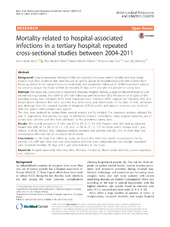| dc.description.abstract | Background: Hospital-associated infections (HAIs) are reported to increase patient mortality and incur longer hospital stays. Most studies to date have focused on specific groups of hospitalised patients with a rather short follow-up period. In this repeated cross-sectional study, with prospective follow-up of 19,468 hospitalized patients,we aimed to analyze the impact of HAIs on mortality 30 days and 1 year after the prevalence survey date. Methods: The study was conducted at Haukeland University Hospital, Norway, a large combined emergency and referral teaching hospital, from 2004 to 2011 with follow-up until November 2012. Prevalence of all types of HAIs including urinary tract infections (UTI), lower respiratory tract infections (LRTI), surgical site infections (SSI) and blood stream infections (BSI) were recorded four times every year. Information on the date of birth, admission and discharge from the hospital, number of diagnoses (ICD-10 codes) and patient’s mortality was retrieved from the patient administrative data system. The data were analysed by Kaplan-Meier survival analysis and by multiple Cox regression analysis, adjusted for year of registration, time period, sex, type of admission, Charlson comorbidity index, surgical operation, use of urinary tract catheter and time from admission to the prevalence survey date. Results: The overall prevalence of HAIs was 8.5 % (95 % CI: 8.1, 8.9). Patients with HAIs had an adjusted hazard ratio (HR) of 1.5 (95 % CI: 1.3, 1.8,) and 1.4 (95 % CI: 1.2, 1.5) for death within 30-days and 1 year, relative to those without HAIs. Subgroup analyses revealed that patients with BSI, LRTI or more than one simultaneous infection had an increased risk of death. Conclusions: In this long time follow-up study, we found that HAIs have severe consequences for the patients. BSI, LRTI and more than one simultaneous infection were independently and strongly associated with increased mortality 30 days and 1 year after inclusion in the study. | en_US |

